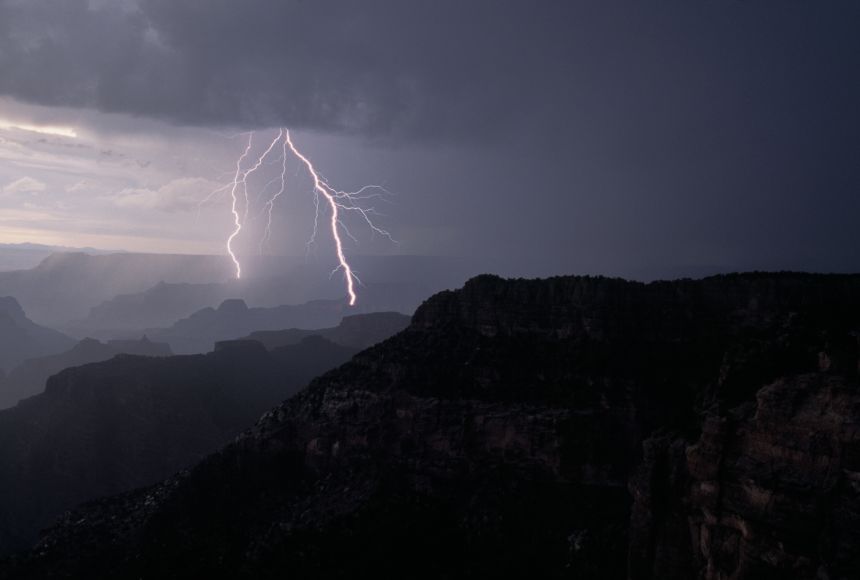The overwhelming majority (97 percent) of scientists agree that climate change is real, and that it is caused by human activity. At the same time, however, we have had some record-breaking cold winters. In January 2019, a polar vortex plunged parts of North America into Arctic conditions. It might seem counterintuitive, but cold weather events like these do not disprove global warming. That's because weather and climate are two different things.
Weather Refers to Short-term Conditions
Weather refers to the short-term conditions of the lower atmosphere, an area that begins at Earth's surface and extends up to 19.3 kilometers (12 miles) high. Weather conditions include precipitation, temperature, humidity, wind direction, wind speed, and atmospheric pressure. It could be sunny, cloudy, rainy, foggy, cold, hot, windy, stormy, or snowing.
The sun drives different types of weather by heating air in the lower atmosphere at varying rates. Warm air rises and cold air rushes in to fill its place, causing wind. These winds, along with water vapor in the air, influence the formation and movement of clouds, precipitation, and storms.
The atmospheric conditions that influence weather are always changing, which is why the weather is always changing. Meteorologists analyze data from satellites, weather stations, and buoys, which are instruments that float in the ocean. The data help them predict weather conditions over the upcoming days or weeks. Weather forecasts are very important. They warn people of dangerous weather conditions, like big storms, which can cause flash flooding, or dry winds, which can whip up forest fires.
Climate Refers to Atmospheric Conditions
While weather refers to short-term changes in the lower atmosphere, climate refers to atmospheric conditions over longer periods of time, usually 30 years or more. This is why it is possible to have an especially cold spell even though, on average, global temperatures are rising. The cold winter is a relatively small atmospheric change within a much larger, long-term trend of warming.
Despite their differences, weather and climate are linked. As with weather, climate depends on precipitation, wind speed and direction, humidity, and temperature. Climate can be thought of as an average of weather conditions over time. More importantly, a change in climate can lead to changes in weather patterns.
Climate conditions vary in regions of the world and influence the types of plants and animals that live there.
Fossil Fuel Use Has Increased Climate Change
Climate change is not a new concept. The global climate has changed many times over the course of Earth's history. However, it is changing much faster now than it has in the past, and this time human activities are to blame.
One of the leading factors contributing to climate change now is the burning of fossil fuels such as coal, gas, and oil, which we use for transport, energy production, and industry. Burning fossil fuels releases large amounts of carbon dioxide (CO2) into the atmosphere; CO2 is one of a group of chemicals known as greenhouse gases. Greenhouse gases allow heat from the sun to enter the atmosphere, but stop it from escaping, much like the glass of a greenhouse. The overall effect is that the global temperature rises, leading to global warming.
Global warming is already affecting the planet as glaciers and Arctic sea ice are melting, sea levels are rising, and there is an increased frequency and intensity of extreme weather events. The planet has already warmed by about 0.8 degrees Celsius (1.4 degrees Fahrenheit) in the last century, and temperatures have continued to rise. Animals and plants are moving to cooler areas.
Climate change makes extreme weather more likely. In 2018, at least 5,000 people were killed and 28.9 million more required aid as a result of extreme weather events like floods, wildfires, hurricanes, or typhoons. It is likely that more frequent and more severe weather events are on the horizon.
Worldwide Efforts to Address Global Warming
Scientists first discovered and explained the physics of greenhouse gases in the early to mid-1800s. In 1896, Swedish scientist Svante Arrhenius first proposed that humans could influence the climate and cause global warming by releasing carbon dioxide into the atmosphere. In the late 1930s, scientists found that temperatures were already rising but it took until the 1980s for the science to gain acceptance and for action to be taken.
In 1988, the global community came together to form the Intergovernmental Panel on Climate Change (IPCC). Since then, leaders from around the world have agreed to a series of goals to lower CO2 emissions to combat climate change. The latest is the 2015 Paris Agreement, in which 197 countries pledged to stop global temperatures from rising by more than two degrees Celsius (3.6 degrees Fahrenheit). All United Nations member states agreed to "take urgent action to combat climate change and its impacts." In 2017, however, the United States, which releases the second-largest amount of greenhouse gases in the world, announced it would withdraw from the agreement.
